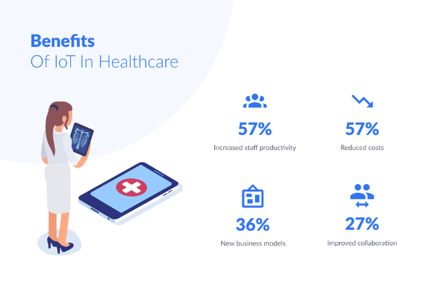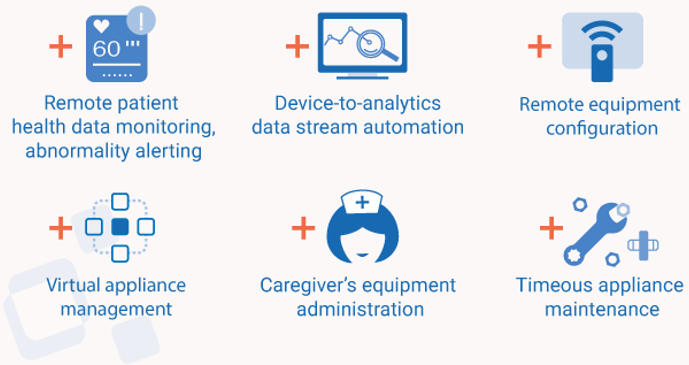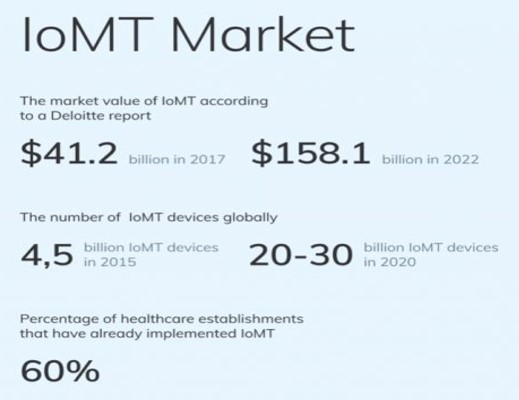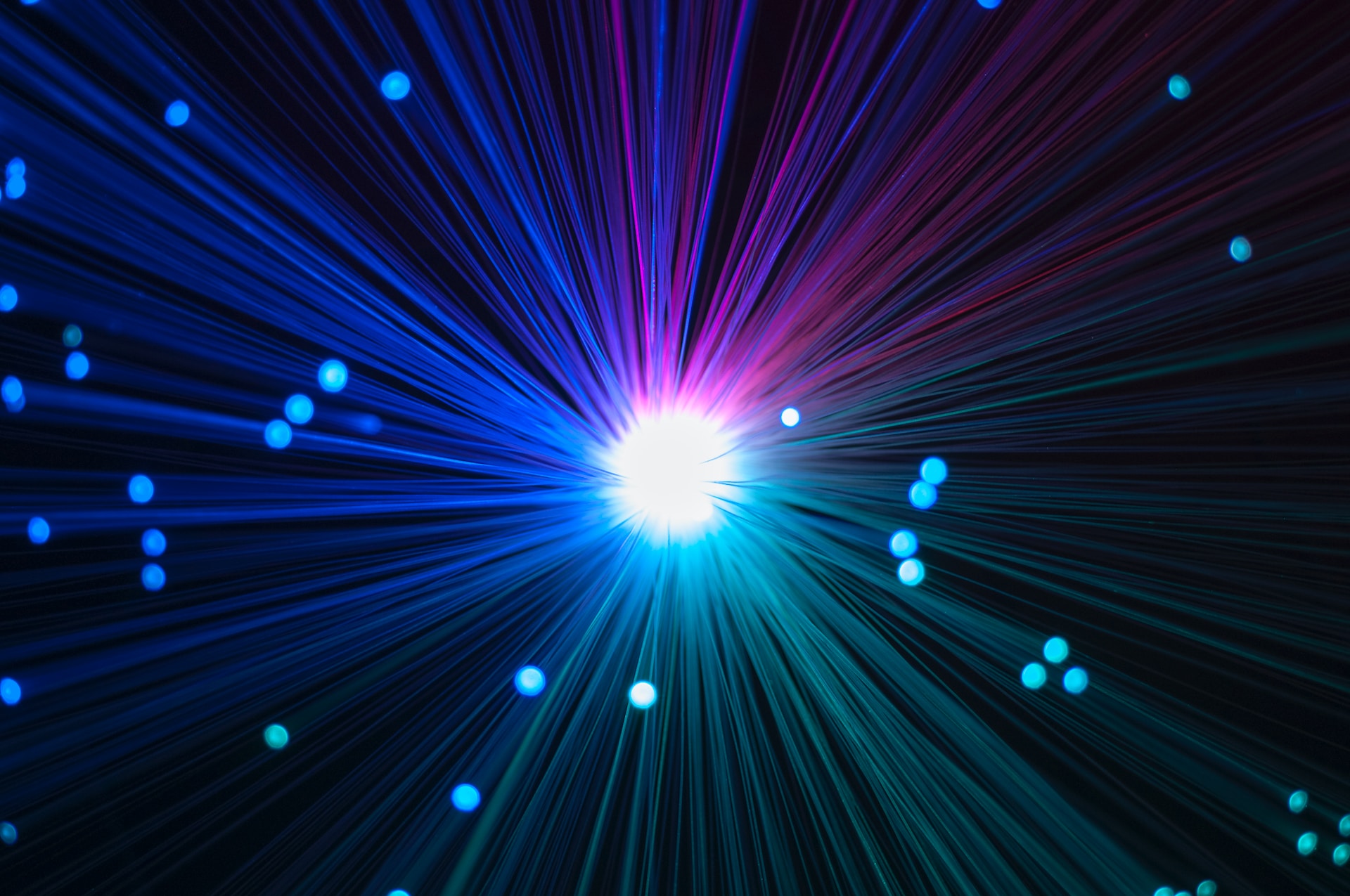IoT in Healthcare

Introduction
The way we live and work is about to change as a result of the Internet of Things. And if technology achieves its full potential, every area of our life will undergo a fundamental transformation. In the healthcare industry, where patient data has been mostly recorded using pen and paper for decades, this type of disruption is clearly visible. But today, significant changes are being made in healthcare technology.
Patients can now arrange appointments using digital healthcare applications without having to phone a doctor's office and wait for a receptionist. Through apps on their cellphones, healthcare information technology enables doctors to take information with them wherever they go. There are no indications that this rising connectedness will slow down. In actuality, it's simply speeding up. By 2028, the market for internet of medical things (IoMT) is projected to be worth $187.60 billion, more than four times what it was in 2020 ($41.17 billion).
In summary, improved medical care and more accessible data are two benefits of increased connectivity. Here is a roadmap of the IoT's impact on healthcare's past, present, and future.
To keep up with the demands of the workplace, doctors have adapted and embraced digital tools. These needs are being pushed by advancing technologies like electronic health records (EHRs) and precision medicine as well as by changing business models like value-based compensation and virtual care.
Delivering high-quality, affordable care depends in large part on the integration of technological systems that include patient data. But because commercial incentives among industry participants are out of alignment and patient data is dispersed too widely, long-standing obstacles to healthcare interoperability still exist.
What is Internet of Things?
The term "internet of things" refers to the interconnection of physical or linked objects like vehicles, buildings, and more. Software, electronics, sensors, network connectivity, and actuators are all built into these devices to aid in data collection and transmission. "The infrastructure of the information society" is another way to describe IOT. Through the current network infrastructure, devices can be detected or controlled remotely thanks to the internet of things.
In order to increase effectiveness, economic benefit, and accuracy, this also creates potential for direct integration of the world into computer-based technical systems. The internet of things has recently redefined how people, gadgets, and apps interact with one another, changing the way healthcare is delivered. IoT has developed innovative and effective tools that lead to integrated healthcare, ranging from personal fitness, implanted technology, and wellness sensors to surgical robots. It improves treatment outcomes, lowers healthcare costs, and delivers better patient care. Hospitals may greatly benefit from the IoT by promoting wellness through automated workflow and superior process design.

What can IOT do for Healthcare ?
Before the Internet of Things, patients could only communicate with doctors face-to-face, over the phone, or by text. There was no feasible mechanism for medical professionals or facilities to continuously evaluate patient health and offer advice. Remote monitoring in the healthcare industry is now possible thanks to Internet of Things (IoT)-enabled devices, releasing the potential to keep patients safe and healthy and enabling doctors to provide excellent treatment. As doctor-patient interactions have gotten simpler and more effective, it has also raised patient participation and satisfaction. Additionally, remote patient monitoring shortens hospital stays and avoids readmissions by keeping an eye on patients' health. IoT has a huge impact on lowering healthcare expenses and enhancing patient outcomes. Without a question, IoT is revolutionizing the healthcare sector by changing how devices and people interact while providing healthcare solutions. Applications of IoT in healthcare are advantageous to patients, families, doctors, hospitals, and insurance providers.
IoT for Patients
Patients can get individualized care with the help of wearable technologies like fitness bands and other wirelessly connected equipment like blood pressure and heart rate monitor cuffs, glucometers, etc. These gadgets can be programmed to remind users to keep track of their blood pressure changes, appointments, appointments, and many other things. IoT has altered people's lives, particularly those of elderly patients, by making it possible to continuously track medical issues. Families and individuals who live alone are significantly impacted by this. A person's alarm mechanism alerts concerned family members and medical professionals to any disruptions or changes in their regular activities.
IoT for Physicians
Physicians can better monitor patients' health by utilizing wearables and other home monitoring devices that are IoT-enabled. They can monitor a patient's adherence to their treatment regimen or any urgent medical needs. Healthcare personnel may now actively engage with patients and be more vigilant thanks to IoT. IoT device data can assist doctors in choosing the most effective course of therapy for patients and achieving desired results.
IoT for Hospitals
There are numerous other applications for IoT devices in hospitals besides patient health monitoring. The real-time position of medical equipment like wheelchairs, defibrillators, nebulizers, oxygen pumps, and other monitoring equipment is tracked using IoT devices tagged with sensors. Real-time analysis can also be done of the placement of medical personnel at various sites. Patients in hospitals are extremely concerned about the spread of infections. Patient infection can be avoided with the aid of IoT-enabled hygiene monitoring equipment. IoT devices are also useful for asset management tasks like controlling pharmacy inventory and checking refrigerator temperatures as well as controlling humidity and temperature in the environment.
IoT for Health Insurance Companies
With IoT-connected intelligent devices, health insurers have a lot of options. Health monitoring device data can be used by insurance companies' underwriting and claims departments. They will be able to identify candidates for underwriting and discover fraud claims thanks to this data. In the underwriting, pricing, claims-handling, and risk assessment procedures, IoT devices increase transparency between insurance companies and their clients. Customers will have sufficient visibility into the underlying reasoning behind every decision taken and the results of the process in light of IoT-captured data-driven decisions in all operational operations.
Customers of insurers may receive rewards for using and sharing health data produced by IoT devices. Customers that use IoT devices to monitor their regular activities, adherence to treatment programmes, and general health precautions can earn rewards. This will drastically lower claims for insurance. Insurance firms may be able to verify claims using IoT devices and the data they collect.

Redefining Healthcare
There are several opportunities now that IoT devices tailored to the healthcare industry are proliferating. Additionally, the enormous amount of data that these linked devices produce has the potential to revolutionize healthcare. The four steps in the IoT architecture can be thought of as stages in a process. The four stages are interconnected in such a way that information is gathered or processed at one stage and provides value in the following stages. Integrating values into the process results in intuitions and offers exciting commercial opportunities.
Step 1: The deployment of connected devices, such as sensors, actuators, monitors, detectors, video systems, etc., is the first phase. These gadgets gather the information.
Step 2: Analogue data typically obtained from sensors and other devices must be combined and transformed to digital data in order to be processed further.
Step 3: The data is pre-processed, standardized, and transferred to the data center or Cloud after it has been digitized and aggregated.
Step 4: The final data is managed and analyzed at the necessary level in step four. When advanced analytics are used on this data, it produces useful business insights for sound decision-making.
By providing better care, better treatment outcomes, and lower costs for patients, as well as better processes and workflows, increased performance, and a better patient experience for healthcare providers, IoT is transforming healthcare.
The major advantages of IoT in healthcare
Cost-cutting: IoT makes it possible to monitor patients in real-time, thereby reducing the number of pointless doctor visits, hospital stays, and readmissions.
Better Treatment: It gives complete openness and empowers doctors to make decisions based on the best available data.
Earlier Illness On the basis of symptoms, ongoing patient monitoring and real-time data might assist diagnose diseases at an early stage or even before they emerge.
Continuous health monitoring makes it possible to provide proactive medical care.
Management of medications and Medical Equipment: Managing medications and medical equipment is a significant concern in the healthcare sector. Through connected devices, these are effectively monitored and used at lower prices.
Error reduction: Data from IoT devices not only aids in effective decision-making but also guarantees error-free healthcare operations with lower system expenses.
IoT in healthcare is not without difficulties. Huge volumes of data, including sensitive information, are collected by linked IoT devices, raising questions about data security. Adequate security measures must be put in place. Through real-time health monitoring and access to patient health data, IoT explores new facets of patient care. Healthcare stakeholders can use this data to increase patient satisfaction and health, create new business opportunities, and enhance operational efficiency. In an increasingly connected world, being able to utilise this digital power would set one person apart from another.
Benefits of IoT in healthcare
Simultaneous Reporting and Monitoring
In the event of a medical emergency like heart failure, diabetes, asthma attacks, etc., real-time monitoring via connected devices can save a million lives. Connected devices can gather useful medical and health-related data when real-time condition monitoring is implemented using a smart medical device connected to a smartphone app. The Internet of Things (IoT)-connected device gathers and transmits health data, including measurements of blood pressure, oxygen and blood sugar levels, weight, and ECGs. The information is kept in the cloud and can be given to a person who has been given permission to access it.
End-to-End Connectivity and Affordability
Through healthcare mobility solutions, IoT can assist in automating healthcare and patient healthcare processes. Interoperability, machine-to-machine connectivity, information exchange, and data transfer enabled by IoT in healthcare greatly reduce the cost of providing healthcare services.
As a result, this technology-driven structure can reduce expenses by reducing unnecessary visits and using resources of higher quality. enhancing resource allocation and planning throughout the process.
Data Assortment and Analysis
It's not as simple as it sounds for healthcare practitioners to manage a large volume of data. Through mobility solutions powered by IoT, real-time data collected by IoT-enabled mobile devices may be analyzed and segmented. As a result, less raw data will need to be collected, and this will enable important healthcare analytics and data-driven insights, which will ultimately decrease errors and accelerate decision-making.
Tracking and Alerts
With constant notifications and real-time alerts for proper monitoring, analysis, and diagnosis, real-time tracking and alerts in life-threatening situations can prove to be a lifesaver to protect a crucial patient's health. Real-time tracking, notification, and monitoring are made possible by IoT-powered healthcare mobility solutions. This enables more hands-on treatments, improved accuracy, and appropriate doctor intervention, all of which improve the overall patient care delivery outcomes.
Remote Medical Assistance
When a patient needs medical care but is unable to reach a doctor because of obstacles like distance or ignorance, it is a horrible situation. The issue is rooted in IoT-enabled mobility solutions that can provide patients with appropriate medical care while they are on the go.
Through healthcare delivery networks connected to patients through IoT devices, patients can take prescription medications right at home.
Challenges of IoT in healthcare
Data Security and Privacy
Data Security and Privacy is one of the most serious problems that IoT is now facing. Real-time data collection is possible with IoT-enabled mobile devices, however most of them do not adhere to data standards and protocols. Regarding ownership and control of data, there is a lot of confusion. As a result, the data saved in IoT-enabled devices is vulnerable to data theft and is therefore more accessible to hackers who want to compromise personal health data. False health claims and the fabrication of phony IDs for prescription purchases and sales are two instances of how IoT device data has been misused.
Integration: Multiple Devices & Protocols
The application of IoT in the healthcare industry is hampered by the integration of many device types. This obstacle exists because device makers cannot agree on a communication protocol and set of standards.
This leads to a situation where each manufacturer develops its own unique ecosystem of IoT devices that are incompatible with the products and services of rival firms. There is no synchronous protocol that might be used for data aggregation in such a scenario. The process is slowed down by this non-uniformity, which also limits how far IoT in healthcare can be scaled.
Data Overload and Accuracy
The inconsistency of data and communication methods makes it challenging to aggregate data for critical understanding and analysis. IoT gathers data in large quantities, so for efficient data analysis, the data needs to be divided into manageable chunks without being overloaded with fine accuracy. In the long run, the overabundance of data may also have an impact on how decisions are made in the hotel industry.
Cost
This point might not surprise you at all. When intending to consider IoT app development for healthcare mobility solutions, costs are one of the bigger challenges. However, if the IoT solution actually solves a real problem, the costs are totally justified.
Even though you'll invest a lot of money and resources into developing an IoT application, the benefits will be enormous when your company uses IoT to improve business processes, generate more revenue streams, and open up new business opportunities while also saving time and labor costs.
In healthcare, IoT accomplishes the following:
Reducing the wait time in emergency rooms
Tracking of patients, employees, and stock
Improved medication management
Ensuring that essential hardware is available
Popular types of IoT devices
Hearables
Hearables are promoted as the modern hearing aid for those who have lost their ability to interact with the outside world due to hearing loss. It is admirable how IoT-powered devices have changed the world with hearing aid solutions. Your cellphones can sync with hearables so you can use Bluetooth on them. Real-world sounds can also be filtered, equalized, and given layered qualities.
Doppler Labs is one of the well-known Hearables instances.
Ingestible Sensors
Ingestible Sensors are, well, ingestible pill-sized sensors that enter our bodies to monitor the meds and alert users/doctors in case of any irregularity. They are a true modern science miracle. These sensors could be a godsend for diabetes patients as they would aid to reduce symptoms and offer a disease's early warning.
Proteus Health, which is used for better insights, analysis, and care, is one of the notable instances.
Moodables
a mood-improving tool that can improve your mood all day long! Although it may sound fanciful, it is surprisingly close to truth.
The development of mood elevator sensors has already begun at Thync and Halo Neurosciences. Head-mounted wearables known as "Mood-ables" work by delivering low-intensity electricity to the brain to improve mood.
Computer Vision Technology
Drone technology that attempts to replicate visual perception in order to enable decision-making based on it has been made possible by computer vision technology and artificial intelligence.
Computer vision technology is used by drones like Skydio to recognize objects and avoid them. People who are blind or visually challenged now have much easier access to this technology.
Healthcare Charting
IoT-enabled gadgets cut down on a lot of the manual labor. For instance, when charting patients, a doctor must use IoT devices. All kinds of od data, including blood pressure, body temperature, and others, can be measured using IoT sensors in this scenario and charted on an app that is connected to the measurement equipment via IoT.
Additionally, it facilitates easy access to the patient's data for review. A doctor's manual charting might be reduced by up to 15 hours per week with the help of an IoT application.
How is IoT Linked with Intellectual Property Rights (IPRs)?
Industry giants including Dell, LG, Samsung, Qualcomm, Google, Rolls Royce, and others have made major investments in IoT. Intellectual Property Rights (IPRs) have a lot of potential in this area because inventions are used throughout the entire creative process.
IoMT & Patents
A patent may be issued for any inventive work that is new, non-obvious, and industrially useful. However, it is crucial in the field of IoMT to carefully craft the claims of the Patent Application while making sure they do not fall under the classification of being a "abstract idea." In the well-known Alice decision, the Supreme Court made it clear that just implementing a "abstract idea" on a computer would not qualify for the granting of patent rights. Contrarily, an invention that gives the user power over a tangible thing, significantly advances an existing technology, or offers more than a regular and conventional solution to a well-known or existing issue is not considered "abstract" under the law and is therefore eligible for patenting.
Therefore, one method of creating a thorough patent application is to draught claims from a unilateral perspective that describe how they might enhance current practises and the healthcare sector. Since all devices are supported in this industry due to interoperability, the issue of infringement is fairly important.
IoMT & Software Patents
Although some nations forbid the patenting of software, rights can still be protected by embedding the software into a gadget or other product. These are referred to as "computer-related inventions" (CRIs) since the hardware and software work together to circumvent legal restrictions. However, the programme itself must satisfy the fundamental criteria for getting patent protection, which are that it must be innovative, non-obvious, industrially relevant, and unique.
IoMT & Copyright Protection
A creative work that is original is protected by copyright, and this covers computer software as well as visual and performing arts like music and movies. The IoMT device's underlying software would require a lengthy lifecycle in the creator's favor in order to be protected. Computer programmes, the graphical user interface, and the data they collect and organize are all covered by copyright protection.
IoMT & Industrial Design Protection
Even though a product's utilitarian features make up the majority of its first impression, its appeal or feel still matters. It is essential to design and build IoMT devices that are functional and aesthetically pleasing. It aids in gaining an advantage in the current cutthroat market and prohibits tampering and copying of such designs to produce counterfeit goods.
IoMT & Trade Secrets
It is best to keep the specifics of a novel implementation of IoMT under wraps if it leans more towards specialized analytics or is founded in the software logic behind a service. It may be helpful to get into a Non-Disclosure Agreement (NDA) when communicating with outside parties and hiring personnel who use such technology or are largely aware of it within the organization.
Potential Risk for Inventors of IoMT
As previously mentioned, IoMT makes use of a variety of technologies, including sensors, actuators, and even wired and wireless networking. One might infer from the terrain that some of these technologies are recent while others have stood the test of time. As a result, each player's Intellectual Property (IP) has a different range. There is a danger of infringing the rights of the earlier invention since the rights of the other inventor may be narrower and less significant than the rights of the existing inventor. As a result, a new player (creator) must think about these infringement dangers and solutions to handle such legal issues. A good option is to make sure that any contracts one enters into with vendors and suppliers contain a robust indemnity clause. Additionally, getting licences can be beneficial. If not, building a solid invalidity defence base can. Additionally, determining the scope of the IoMT product while carrying out an exhaustive Freedom to Operate (FTO) operation can prove to be advantageous prior to preparing a patent application.
The introduction of this recently discovered technology has resulted in high consumer demand and supply, as well as encouraged creative minds to make the most of these chances. IPRs can help the rapidly expanding industry and support IoT technology governance and regulation. Because the issue of interoperability corresponds to data sharing, which leads to tampering with privacy rights, we should anticipate more substantial technological advancement and complex litigation in this area. The interoperability and interworking of technology can therefore lead to a variety of unanticipated problems including cyberterrorism, blackmail, bullying, etc.
The entities will need to create technologies that can manage data and the communication between them effectively while implementing the necessary security measures to protect the users of such technology from any potential unwanted effects. It will be interesting to watch how the legal changes, which are impacted by the legislators, politicians, investors, and other relevant entities, construct the laws and regulations that would shape the industry and guarantee a flawless use of IoT.

Please feel free to reach out to one of our subject matter experts at info@effectualservices.com
to explore, how we can help you & make the world a better place to live in!!!
Effectual’s IOMT RESEARCH FRAMEWORK is a deep dive into this ecosystem and shall help you understand the intricacies of this nascent innovative domain with insights backed with credible data sources. Some ways we can help include, but not limited to - Performing any previous art or freedom to operate searches to help you better grasp the environment surrounding your invention or business endeavors. If certain methods of IP protection are more appropriate for your technological or business goals, we can help you strategize effectively to plan for future & in making continuous innovation a part of your working model.
Solutions Driving Innovation & Intelligence
Enabling Fortune 500's, R&D Giants, Law firms, Universities, Research institutes & SME's Around The Globe Gather Intelligence That
Protects and Nurtures Innovation Through a Team of 250+ Techno Legal Professionals.

